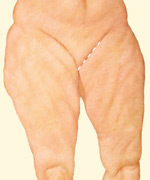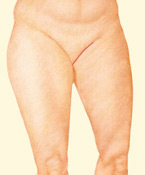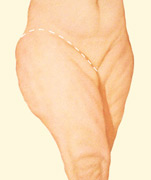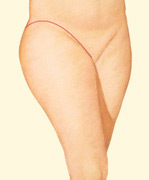Thigh Lift Washington DC
Introduction
If you have concerns of either excess fat on the medial upper thighs, loose skin on the inner thighs, or extra fat and/or skin on the lateral thighs, you may be a candidate for a thigh lift procedure.
Candidates for thigh lift surgery have:
- Body weight that is relatively stable
- Excess tissue along the inner (medial) thigh and/or the outer thigh
- No medical conditions that can impair healing or increase risk of surgery
- Positive outlook and realistic goals for thigh lift surgery
- Commitment healthy lifestyle with good nutrition and fitness


Medial Thigh Lift


Outer Thigh Lift
The Best Candidates for Thigh Lift
A thigh lift reshapes the thighs by reducing excess skin, and in some cases fat, resulting in smoother skin and better-proportioned contours of the thighs and lower body. If fitness and weight loss efforts have not achieved your goals for a body that is firmer, more youthful-looking and more proportionate to your overall body image, a surgical thigh lift may be right for you.
What is a thigh lift?
Incision patterns vary based on the area or areas to be treated, degree of correction and patient and surgeon preference.One common technique used for a thigh lift places incisions in the groin, extending downward wrapping around the back of the thigh. The underlying tissue will be reshaped and tightened, and skin will be reduced and redraped resulting in more proportionate and smoother body contours.
You may qualify for a minimal incision medial thigh lift, which involves an incision only in the groin area. Dr. Baker will help you determine what is most appropriate to achieve your goals. Improving the contours of the outer thigh may require an incision extending from the groin around the hip.
Through these incisions your Dr. Baker will tighten tissues for a smoother, better-toned lower body contour. Advanced techniques usually allow incisions to be placed in strategic locations where they can be hidden by most types of clothing and swimsuits. However, incisions may be extensive. Deep support sutures within underlying tissues help to form the newly shaped contours. Sutures close the skin incisions.
Thigh lifts are not intended strictly for the removal of excess fat. Liposuction alone can remove excess fat deposits where skin has good elasticity and is able to naturally conform to new body contours. In cases where skin elasticity is poor, a combination of liposuction and thigh lift techniques may be recommended.
Whether Dr. Baker performs your thigh lift at Georgetown University Hospital (Washington D.C.), Inova Fairfax Hospital (Falls Church, VA) or an ambulatory surgical facility (McLean, VA), you should arrange for someone to drive you home after your surgery, and to help you out for a day or two.
Anesthesia
Medications are administered for your comfort during the surgical procedures. The choices include intravenous sedation and general anesthesia. Dr. Baker will recommend the best choice for you.
Results of Thigh Lift Surgery
The smooth tight contouring that result from a thigh lift is apparent almost immediately, although initially obscured by some swelling and bruising. You may be required to wear a compression garment for several weeks following your procedure to minimize swelling and support the tissues as they heal.
Following a thigh lift, skin quality is dramatically improved both in appearance and feel. The decision to have thigh lift surgery is extremely personal and you will have to decide if the benefits will achieve your goals and if the risks and potential complications are acceptable.
Dr. Baker will explain in detail the risks associated with surgery. You will be asked to sign consent forms to ensure that you fully understand the procedure you will undergo and any risks and potential complications.
Recovery
When your procedure is completed, dressings or bandages may be applied to your incisions, and you may be wrapped in an elastic bandage or a compression garment to minimize swelling and to support your new contours as you heal. One or more small, thin tubes may be temporarily placed under the skin to drain excess fluid or blood that may collect.
The practice of medicine and surgery is not an exact science. Although good results are expected, there is no guarantee. In some situations, it may not be possible to achieve optimal results with a single surgical procedure and another surgery may be necessary.
Following Dr. Baker’s instructions is key to the success of your surgery. It is important that the surgical incisions are not subjected to excessive force, swelling, abrasion, or motion during the time of healing. Dr. Baker will give you specific instructions on how to care for yourself.






